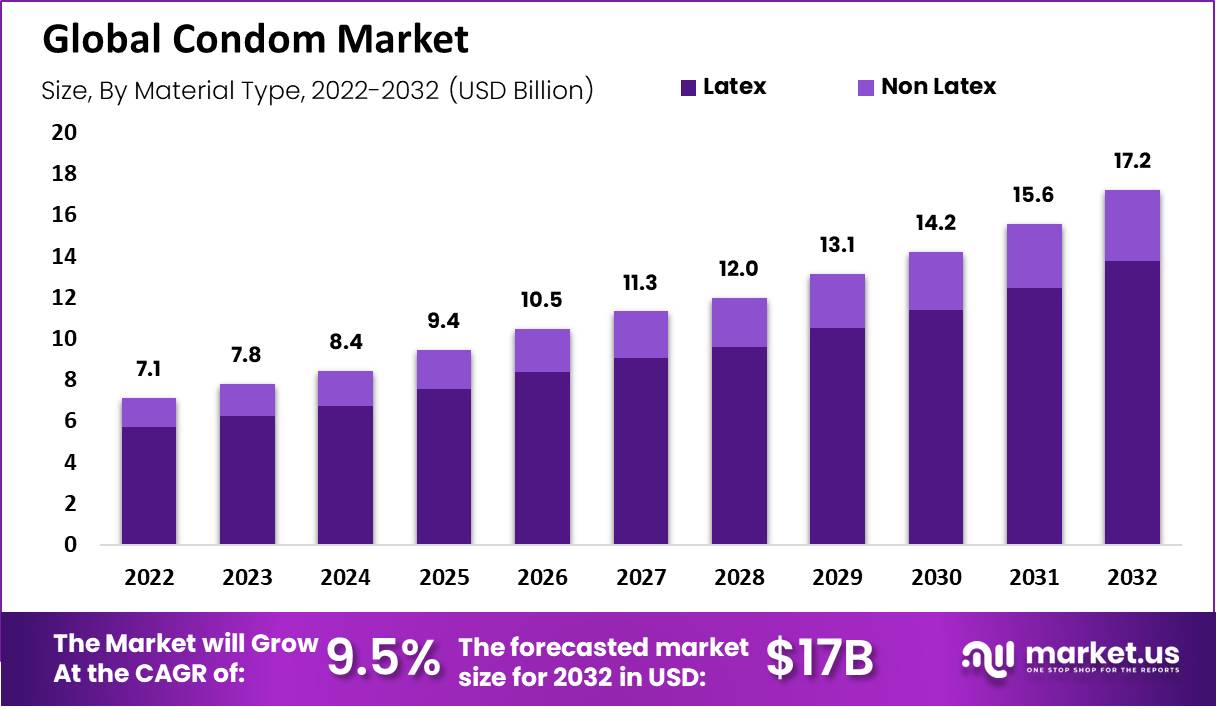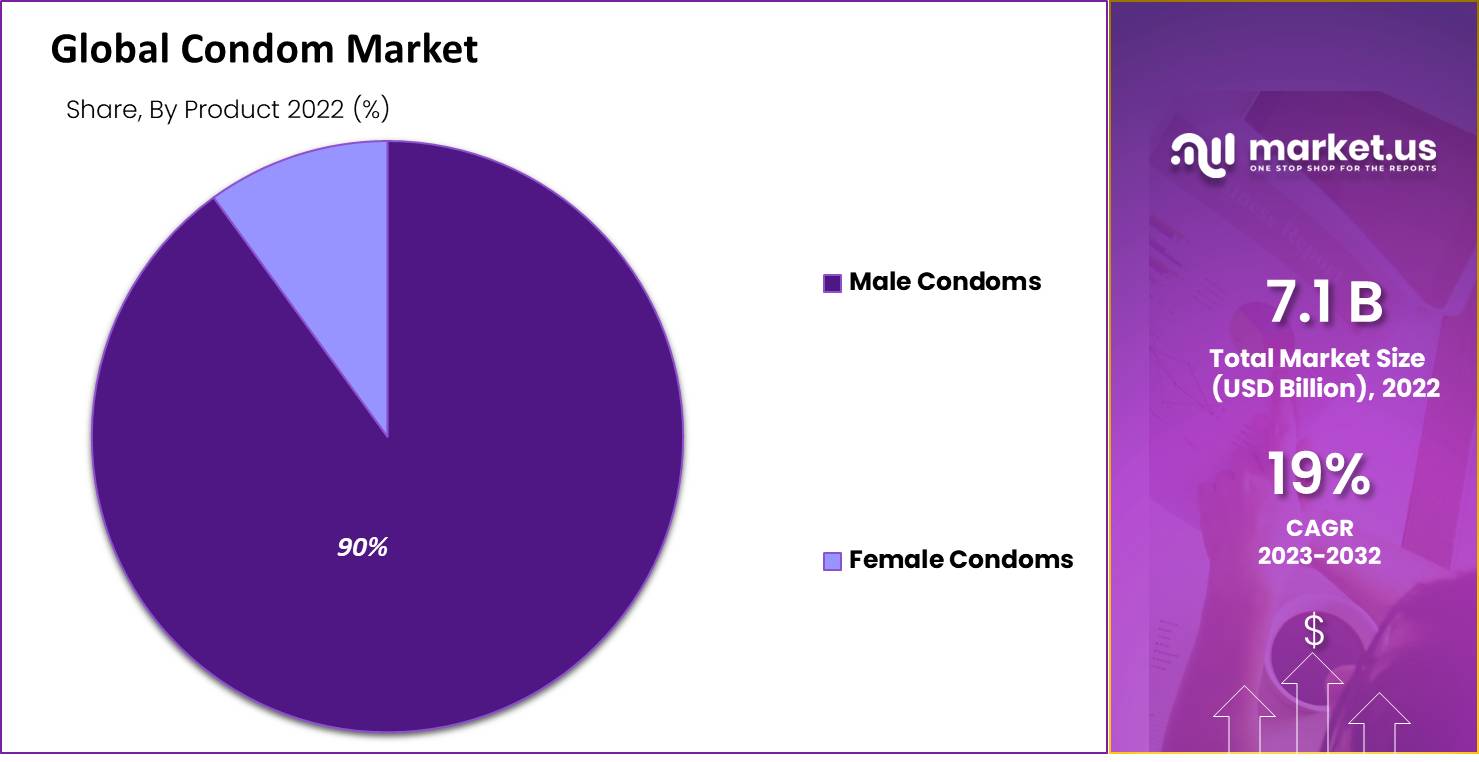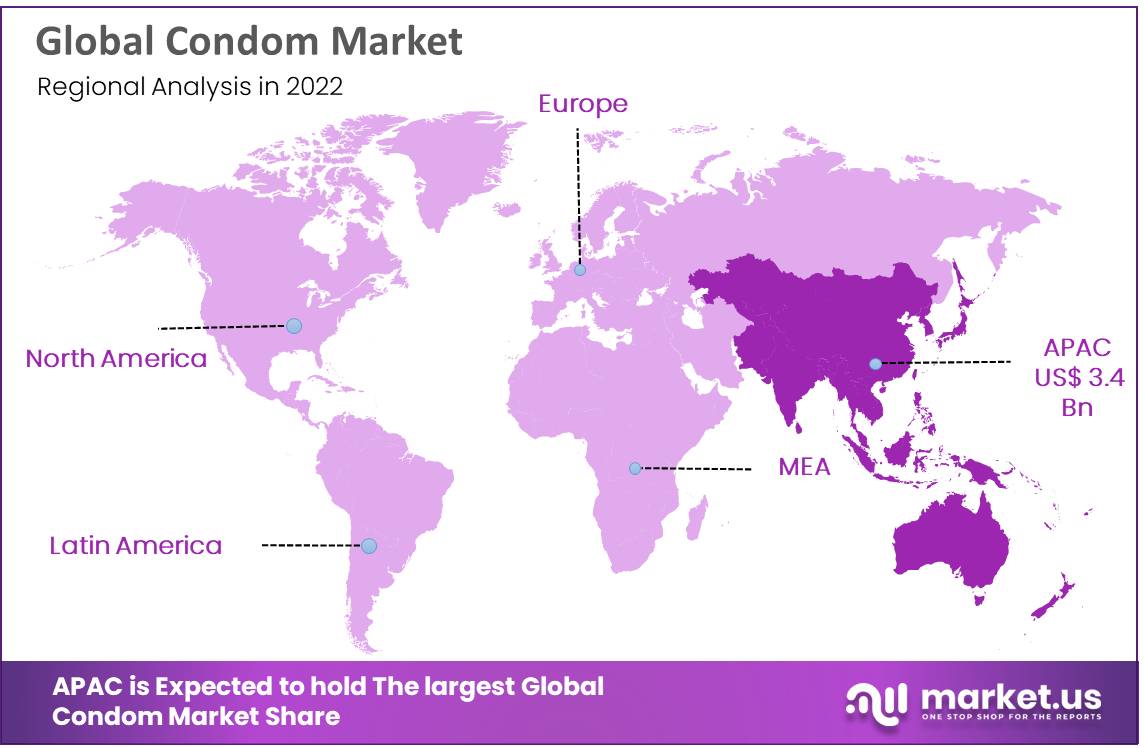Global Condom Market By Material Type (Latex Condoms and Non-latex Condoms), By Product (Male Condoms and Female Condoms) By Distribution Channel (Mass Merchandizers, Drug Stores, and E-commerce) Region and Companies - Industry Segment Outlook, Market Assessment, Competition Scenario, Trends and Forecast 2023-2032
- Published date: Oct 2023
- Report ID: 19318
- Number of Pages: 296
- Format:
- keyboard_arrow_up
Quick Navigation
Report Overview
The global condom market size is expected to be worth around USD 17.9 Billion by 2032 from USD 7.11 Billion in 2022, growing at a CAGR of 9.5% during the forecast period from 2022 to 2032.
Condom market growth is expected to be boosted by rising condom awareness about use, the availability of condoms to meet consumer needs, and efforts to reduce HIV and other STI spread. The market will also be driven by the distribution of condoms free of charge by government agencies. Each country’s government is taking initiatives to increase awareness and encourage the use of contraceptives among the younger generation in order to combat the HIV epidemic and prevent unintended pregnancies. UNAIDS 2020 targets that 90% of HIV-positive people will be aware of their HIV status by 2020, and 90% will be receiving sustained antiretroviral treatment.
Participating countries promote condom use and provide adequate sex education for youth. With the support of UNFPA, other organizations, and governments, condom distribution is free in rural areas. Correctly used, male condoms can prevent pregnancy and sexually transmitted diseases such as HIV by 98%. The UNAIDS Programmed on HIV/AIDS states that condoms can be used consistently and correctly to protect against STDs and unplanned pregnancies. The World Health Organization (WHO) and the Centers for Disease Control and Prevention are playing a major role in spreading awareness about safe sex using condoms. In the last decade, this has led to a significant increase in condom use among sexually active couples.

Key Takeaways
- The condom market is projected to grow at a CAGR of 9.5% from 2022 to 2032.
- Correctly used, male condoms can prevent pregnancy and STDs by 98%.
- The non-latex condoms segment is expected to grow at a CAGR of 9.93%.
- The male condom market experienced a 12.69% CAGR during the forecast period.
- Asia Pacific is expected to have double-digit growth at a 10.38% CAGR.
- Europe’s market will grow at a CAGR of 7.14%.
- The U.S. FDA granted approval to Cupid Limited to market male condoms in the U.S. in August 2020.
- The market for condoms is highly competitive, with global brands like Durex and Trojan, as well as many local and regional players.
- Karex Berhad acquired 100% of the U.S. condom company GP in November 2020.
- Factors driving market growth include rising condom awareness, government initiatives to combat HIV and other STIs, and free condom distribution.
- Drug stores are the leading distribution channel, with e-commerce experiencing the fastest growth.
- Drivers of market growth include increasing awareness, product diversification, and government initiatives.
- Market growth is limited by issues like allergies, tears, and limited awareness in low-income countries.
- Opportunities lie in promoting sexual education programs and increasing awareness of contraceptives to combat STDs.
- The COVID-19 pandemic initially affected demand, but increased product availability is expected to boost market growth.
- Latex condoms are the dominant material type in the market, with latex and non-latex condoms expected to grow due to new product launches.
Material Type Analysis
Latex condoms accounted for the largest share of revenue in the condom market
The latex condom segment accounted for the largest share of revenue in the market. This study analyzed key types of segments, including latex and non-latex. Over the forecast period, the condom market for condoms made of latex and other non-latex is expected to grow due to new products being launched and increased demand from the aging baby boomers. Condoms made from latex are effective between 82% and 98%. This is why most of the brands on the market for condoms are made of latex, which is a type of natural rubber.
It’s more durable and flexible and offers effective contraception and protection from STDs. Non-latex condom segments will experience the fastest growth, with a 9.93% Compound Annual Growth Rate (CAGR), during the forecast period. These condoms have many advantages over latex condoms, such as being thin, odorless, and non-allergic. Due to the increased allergy cases for latex condoms, non-latex condoms were developed. Non-latex condoms can be costlier than latex condoms. They are also less effective at preventing viral infections such as STDs or HIV.
Product Analysis
Market share was dominant in the male condom market
There are two types of condoms on the market male and female. The male condom market has grown due to manufacturers’ emphasis on male condoms rather than female condoms. They also have a wider portfolio. Because of the rising prevalence of HIV/AIDS, many countries in Africa are still underdeveloped. This means that there is a great unmet demand for men’s condoms. Due to their popularity among couples, male condoms are in high demand and hold a high revenue share.
The forecast period will see the fastest growth at a 12.69% CAGR. The acceptance of female condoms is increasing for their ability to reduce the risk of STIs and unplanned pregnancies. FDA granted a genderless rebranding to a female condom in January 2019 and gave it a generic name, “single-use inner condom.” It was classified under the counter. The World Health Organization has set strict requirements for female condoms. Only a few companies have passed this prequalification process, which leaves a lot of potentials for companies to enter the condom market. Due to high unmet demands, top players like Veru, Inc, are targeting this segment.

Distribution Channel Analysis
The market was dominated by the drug store segment
This growth can be attributed largely to the ease of access and availability of drug stores. The trend towards e-commerce is changing due to closed markets and restrictions on physical movement during pandemics. The forecast period will see e-commerce experience a 9.11% compound annual rate (CAGR), the fastest growth. The segment growth is expected to be driven by the availability of discrete delivery services and the freedom to choose from e-commerce platforms.
Recent digitalization has led to increased internet access in underdeveloped and developing countries. This has created opportunities for significant growth in e-commerce platforms. Reckitt Benckiser and Church & Dwight are focusing on online marketing strategies to promote the condom brand. This reflects the potential and importance of e-commerce.
Key Market Segments
By Material Type
- Latex
- Non-Latex
By Product
- Male Condoms
- Female Condoms
By Distribution Channel
- Mass Merchandizers
- Drug Stores
- E-commerce
Drivers
Increased awareness regarding condom use
Major factors that have contributed to the growth of the global condom industry include the growing awareness about he usage of condoms via sex education programs and the rise in incidences of sexually transmitted diseases around the world. The condom market’s growth is also being driven by the increasing use of online distribution channels and the increased adoption of contraceptives to prevent unwanted pregnancies.
Manufacturers have a goal to offer a wide range of products.
Top companies have launched new products that offer many features, capabilities, and exotic fun. Manufacturers are also focusing on creating a broad range of products and improving there product portfolio, as government agencies have run campaigns. This allows for free advertising and boosts sales. In many countries, condoms are also distributed at affordable rates by the government. They are also used to educate citizens about their use, increase awareness, and grow the user base.
Restraints
Market growth is limited by market issues such as allergies and tears.
Product consumption can be affected by allergic reactions to male genitals and lubricants, as well as splitting or tearing of male- and female-based products. A lower awareness level in low-income countries will limit market growth as well as inaccessible products for sexual wellness in rural areas.
Opportunity
The government is working to promote sexual education programs that increase awareness of and reduce the prevalence of sexually transmitted disorders (STDs).
According to UNAIDS Global HIV&AIDS Statistics – 2020 fact sheets, 39.0 Million people had HIV in 2019. In order to increase product demand, governments are now focusing on creating relationships and sex education in schools at an early age. The 100% condom program in Asia, many campaigns like Project against STIS-Public Health England, and initiatives such as sexual and Reproductive Health Awareness Week” and World Contraceptive Day are all examples of collaboration programs. Respective governments, as well as NGOs working with people affected by STDs, are trying to increase awareness of sexually transmitted disease (STIs) in order to promote contraceptives. This will likely boost the market growth.
Trends
To Flourish the Market, a New Product is Launched
Market leaders have introduced new products that provide new features and capabilities. They have taken the necessary steps in order to increase reliability and overall enjoyment. Durex has developed a line of Air condoms that are ultra-thin, provide more intimacy and sensitivity, and offer high levels of protection. This series is designed to give you a natural instinctive feeling when using them.
These condoms have been designed to reduce friction, increase lubrication, and prevent stickiness. They provide ultimate comfort. Origami condoms, which were invented using silicone as a raw material and operate in a reciprocating motion that allows for easy movement within the soft silicon lubricated Condom, were re-invented by Bill and Melinda Gates Foundation in 2009. Other market leaders include Hydrogel, The Galactic Cap, and FC2 (the female Condom).
Regional Analysis
Regional analysis shows that Asia Pacific was the region with the highest shareholdings
This region is expected to experience the fastest growth rates during the forecast period. This can be attributed to a rise in demand in countries such as China and India, Australia, and Japan. According to the National Health and Family Planning Commission of China (U.S., U.K., and Japan), the country ranks among the top four countries when it comes to condom production and usage. China has a huge market with potential double-digit growth at a 10.38% CAGR.
Local startups are trying hard to capture market share. A chinese condom made with waterborne polyurethane was launched in Gansu Province in June 2017. According to the company, this Condom had the thinnest protective sheath. It was meant to increase market share for Japanese manufacturers Sagami & Okamoto. Europe’s market will grow at a compound annual rate of 7.14%.
North America was second with the largest market shareholding region. This is due to increasing demand from sex workers and lesbians (MSM). Countries with the highest market shares include France, Germany, and the U.K. To prevent HIV transmission, these countries have launched government initiatives to encourage contraceptive use among their youth population.
As part of its efforts to combat HIV and AIDS, the France Ministry of Health announced in November 2018 that they would reimburse the cost of the prescription of condoms by doctors. North America has seen an increase in condom demand, despite a gradual vaccination drive. COVID restrictions have been relaxed. It is possible to increase condom use, especially among women who use them less than men. Sexual awareness can also help. The need to adopt condoms is further heightened by the rise in the number of sexually transmitted diseases (STDs).

Key Regions
North America
- The US
- Canada
- Mexico
Latin America
- Brazil
- Colombia
- Chile
- Argentina
- Costa Rica
- Rest of Latin America
Eastern Europe
- Russia
- Poland
- The Czech Republic
- Greece
- Rest of Eastern Europe
Western Europe
- Germany
- France
- The UK
- Spain
- Italy
- Portugal
- Ireland
- Austria
- Switzerland
- Benelux
- Nordic
- Rest of Western Europe
APAC
- China
- Japan
- South Korea
- India
- Australia & New Zealand
- Indonesia
- Malaysia
- Philippines
- Singapore
- Thailand
- Vietnam
- Rest of APAC
Middle East & Africa
- Algeria
- Egypt
- Israel
- Kuwait
- Nigeria
- Saudi Arabia
- South Africa
- Turkey
- United Arab Emirates
- Rest of MEA
Key Players Analysis
This market is very competitive, With the presence of global brands like Durex and Trojan. Many local companies are trying to increase market share by launching innovative products, packaging, and promotions to meet local customer demand. To maintain their market position, leading manufacturers are also using acquisitions and partnerships.
Karex Berhad acquired 30% of the U.S. condom company GP in November 2020. This means that GP now owns 100%. LifeStyles Healthcare Pte. is one example of a private company. Cupid Limited and Ltd. have a significant global presence. LifeStyles Healthcare is a strong company with a wide product range and strong employees. Cupid Limited exports male and female condoms to almost 66 countries. This is in order to increase its product range and market presence. Cupid Limited was granted approval by the U.S. FDA to market male condoms in the U.S. in August 2020.
Market Key Players
With the presence of many local and regional players, the market for condoms is fragmented. Market players are subject to intense competition from top market players, particularly those with strong brand recognition and high distribution networks. To stay on top of the market, companies have gained various expansion strategies such as partnerships and product launches.
The following are some of the prominent players in the global condom industry
- Durex
- Okamoto
- Trojan
- Reckitt Benckiser Group Plc
- Church & Dwight Co. Inc.
- Okamoto Industries Inc.
- Cupid Limited Karex
- Ansell
- Sagami
- Gulin Latex
- NOX
- Mayer Laboratories Inc.
- Lifestyles Healthcare Pte Ltd.
- HLL Lifecare
- Fujilatex Co. Ltd
- Okamoto Industries Inc.
- Other Key Players
Recent Development
- FDA-approved condoms from the famous ONE brand in February 2022. There are three condom type such as thin, standard, and my ONE custom-fit condoms. The condoms come in 54 sizes.
- Mankind Pharma company introduced EPIC Condoms (a premium range of flavored condoms) in May 2022.
- IXu was a main key player in sexual health products and launched its first-ever female-based product in Europe in March 2019 with a CE Mark.
Report Scope
Report Features Description Market Value (2022) US$ 7.11 Bn Forecast Revenue (2032) US$ 17.9 Bn CAGR (2023-2032) 9.5% Base Year for Estimation 2022 Historic Period 2016-2022 Forecast Period 2023-2032 Report Coverage Revenue Forecast, Market Dynamics, COVID-19 Impact, Competitive Landscape, Recent Developments Segments Covered By Material Type- Latex Condoms and Non-latex Condoms; By Product- Male Condoms and Female Condoms; By Distribution Channel- Mass Merchandizers, Drug Stores, and E-commerce Regional Analysis North America – The US, Canada, & Mexico; Western Europe – Germany, France, The UK, Spain, Italy, Portugal, Ireland, Austria, Switzerland, Benelux, Nordic, & Rest of Western Europe; Eastern Europe – Russia, Poland, The Czech Republic, Greece, & Rest of Eastern Europe; APAC – China, Japan, South Korea, India, Australia & New Zealand, Indonesia, Malaysia, Philippines, Singapore, Thailand, Vietnam, & Rest of APAC; Latin America – Brazil, Colombia, Chile, Argentina, Costa Rica, & Rest of Latin America; Middle East & Africa – Algeria, Egypt, Israel, Kuwait, Nigeria, Saudi Arabia, South Africa, Turkey, United Arab Emirates, & Rest of MEA Competitive Landscape Durex, Okamoto, Trojan, Reckitt Benckiser Group Plc, Church & Dwight Co., Inc., Okamoto Industries, Inc., Cupid Limited Karex, Ansell, Sagami, Gulin Latex, NOX, Other Key Players Customization Scope Customization for segments, region/country-level will be provided. Moreover, additional customization can be done based on the requirements. Purchase Options We have three licenses to opt for: Single User License, Multi-User License (Up to 5 Users), Corporate Use License (Unlimited User and Printable PDF) Frequently Asked Questions (FAQ)
How much is the Global Condom Market worth?Global market size is worth USD 17.9 Billion by 2032.
What was the value of the Condom Market in 2023?In 2023, the market value stood at USD 7.11 Billion.
What is the CAGR of Condom Market?The Global Condom Market is growing at a CAGR of 9.50% during the forecast period 2022 to 2033.
Who are the major players operating in the Condom Market?Durex, Okamoto, Trojan, Reckitt Benckiser Group Plc, Church & Dwight Co., Inc., Okamoto Industries, Inc., Cupid Limited Karex, Ansell, Sagami, Gulin Latex, NOX, Other Key Players.
Which region will lead the global Condom Market?North America is estimated to be the fastest-growing region during the forthcoming years.

- Durex
- Okamoto
- Trojan
- Reckitt Benckiser Group PLC Company Profile
- Church & Dwight Co. Inc.
- Okamoto Industries Inc.
- Cupid Limited Karex
- Ansell Ltd. Company Profile
- Sagami
- Gulin Latex
- Lennox International Inc. Company Profile
- Mayer Laboratories Inc.
- Lifestyles Healthcare Pte Ltd.
- HLL Lifecare
- Fujilatex Co. Ltd
- Other Key Players
- settingsSettings
Our Clients
| Single User $4,599 $3,499 USD / per unit save 24% | Multi User $5,999 $4,299 USD / per unit save 28% | Corporate User $7,299 $4,999 USD / per unit save 32% | |
|---|---|---|---|
| e-Access | |||
| Report Library Access | |||
| Data Set (Excel) | |||
| Company Profile Library Access | |||
| Interactive Dashboard | |||
| Free Custumization | No | up to 10 hrs work | up to 30 hrs work |
| Accessibility | 1 User | 2-5 User | Unlimited |
| Analyst Support | up to 20 hrs | up to 40 hrs | up to 50 hrs |
| Benefit | Up to 20% off on next purchase | Up to 25% off on next purchase | Up to 30% off on next purchase |
| Buy Now ($ 3,499) | Buy Now ($ 4,299) | Buy Now ($ 4,999) |












